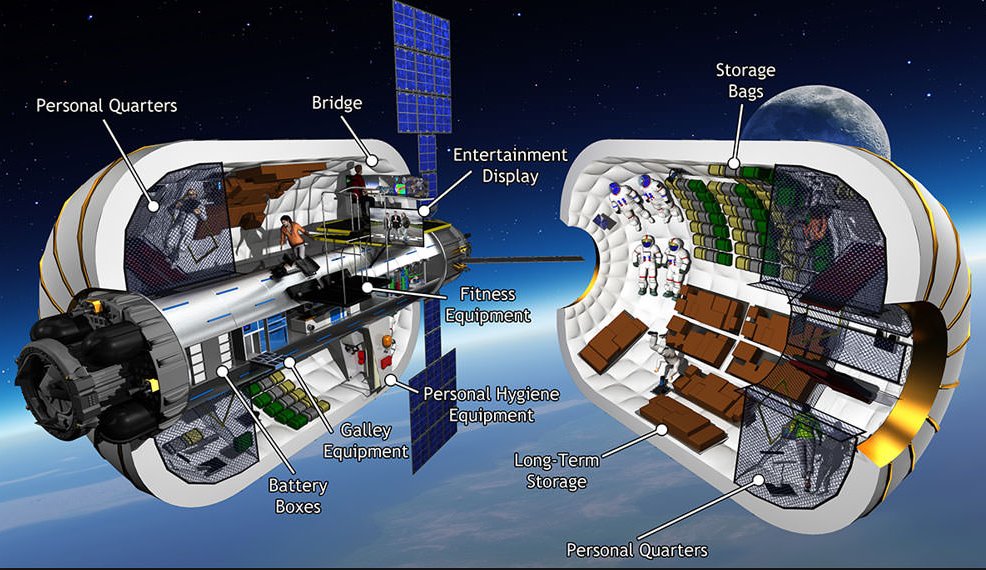Las Vegas-based space firm Bigelow Aerospace has entered into an agreement with Lockheed-Boeing outfit United Launch Alliance to launch its large B330 expandable habitat to the moon’s orbit. The company claims the B330 can double as a commercial space station that can host spacecraft from other companies and help train astronauts for deep space exploration.
A video published along with today’s announcement shows the B330 being launched by a ULA’s upcoming Vulcan rocket and then being docked by a SpaceX Dragon 2 capsule once in orbit. For over a year, a model depicting the B330 mating with a SpaceX Dragon has been on display at the Kennedy Space Center Visitor’s Complex without explanation.
“We are excited to work with ULA on this lunar depot project,” said Robert Bigelow in a statement. “Our lunar depot plan is a strong complement to other plans intended to eventually put people on Mars. It will provide NASA and America with an exciting and financially practical success opportunity that can be accomplished in the short term.”
“This lunar depot could be deployed easily by 2022 to support the nation’s re-energized plans for returning to the Moon,” Bigelow claims. The B330 expandable module is designed to provide up to 12,000 cubic feet of living and work space for astronauts.

Based in Las Vegas, the company was founded when Bigelow saw a program on television about NASA’s now-defunct TransHab project intended to provide an expandable safe living space for humans in orbit.
With profits from ownership of hotel chain Budget Suites of America, Bigelow purchased the habitat module technology from NASA in 2000. Over the course of a decade, Robert Bigelow would invest over $180 million into the project.
“Our philosophy is trying to test everything we can. First, close to home because we don’t want any suicide missions,” he said in an interview with the Observer last year. “The moon is a perfect testing ground for a really dangerous environment and If you can successfully do a lot of things there, you can learn a lot that would be valuable to bases and human habitats on Mars.”
Last April, Bigelow Aerospace launched the BEAM or Bigelow Expandable Activity Module to the International Space Station aboard SpaceX’s Dragon cargo spacecraft. The BEAM is the first commercially-built and owned habitat module to be attached to the orbiting laboratory––specifically, it’s attached to the Tranquility node. The mission also marked a milestone for SpaceX––it was the first time a Falcon 9 rocket was brought home for a landing at sea.
“Space station crew members have entered BEAM 13 times since its expansion in May 2016. The crew has conducted radiation shielding experiments, installed passive radiation badges called Radiation Area Monitors, and they routinely collect microbial air and surface samples,” said NASA.
Now, after completing a full year of testing that involved astronauts actually entering BEAM to test environmental controls and life support, NASA is calling the mission a success and may extend its stay at the ISS.
“NASA’s use of BEAM as part of a human-rated system will allow Bigelow Aerospace to demonstrate its technology for future commercial applications in low-Earth Orbit,” said the agency in a release. “Initial studies have shown that soft materials can perform as well as rigid materials for habitation volumes in space and that BEAM has performed as designed in resistance to space debris.”
Read a Starletter’s profile on Bigelow Aerospace founder and CEO Robert Bigelow.
Photo Credits: Bigelow Aerospace
 Robin Seemangal is a Space Reporter, with a focus on NASA and advocacy for space exploration for the New York Observer. He’s also written for Popular Science and Wired Magazine. He was born and raised in Brooklyn, where he currently resides. You can find him on Twitter and Instagram.
Robin Seemangal is a Space Reporter, with a focus on NASA and advocacy for space exploration for the New York Observer. He’s also written for Popular Science and Wired Magazine. He was born and raised in Brooklyn, where he currently resides. You can find him on Twitter and Instagram.









